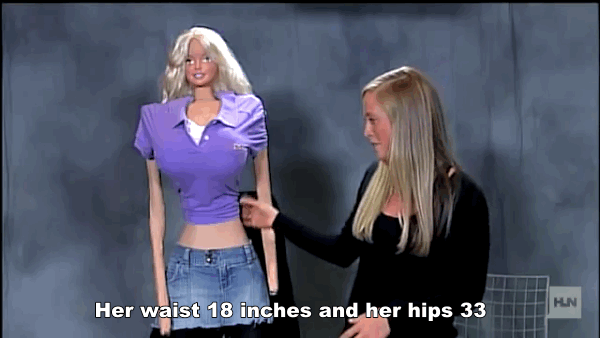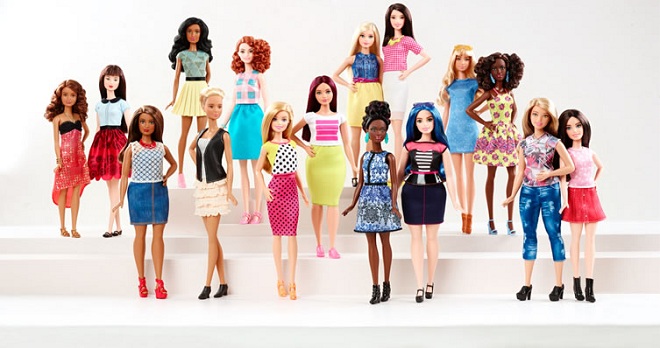Barbie Is Making “Tall”, “Petite” And “Curvy” Dolls, Signalling Huge Shifts Towards Body Positivity
A review from my little sister: "They're more pretty. If we weren't different, then we would all be the same."

Barbie was first inspired in the mid-1950s by a sassy German doll for adults called Bild Lilli — this was in turn based on a cartoon character of the same name who was known for her deliberate manipulation of men and love of sex. “I could do without balding old men, but my budget couldn’t!” is a real phrase she was known for. She was regularly handed out as a joke at bachelor parties.
Unsurprisingly, much has changed since then. As young girls quickly embraced the doll as a kind of aspirational device, much of the raunch was toned down. Barbie became known for her love of fashion, her fun lifestyle and eventually, her diverse career paths. As Mattel are eager to point out when refuting persisting criticisms of the doll’s enforcement of stale gender stereotypes, Barbie was “a businesswoman in 1963, an astronaut in 1965, and a surgeon in 1973 when 9 percent of all doctors were women”. But alongside all this, over more than five decades and nearly three generations of women, her body remained the bizarre-o proportions of a sex doll designed by a weird old German guy.

Today Mattel have finally fixed this. After decades of protest that the doll has negative effects on young girls’ body image promoting an unattainable figure, the manufacturer has announced a new range of Barbie bodies which include “tall”, “petite” and “curvy”. Though this isn’t the first change the doll’s undergone over the years — in 1997 her bust was reduced, her waist was made wider, and her hips were slimmed — it’s definitely the most dramatic. And, combined with the new skin tones and hair textures released last year, it’s a huge win for diversity.
“Barbie reflects the world girls see around them,” said Mattel President Richard Dickson in a press release overnight.
America’s biggest toy company is changing the most famous body in the world https://t.co/zFKXcXgIXa pic.twitter.com/33YjE0jaxI
— TIME.com (@TIME) January 28, 2016
However, this may not be as well-meaning as it seems. As thoroughly covered in a just-released feature story by Time‘s Eliana Dockterman, this move comes at a time when Barbie is floundering in the market she once dominated. She’s threatening to become a cultural relic in a society in which diversity and body positivism is slowly becoming the norm.
“Barbie sales plummeted 20 percent from 2012 to 2014 and continued to fall last year,” Dockterman notes. As traditionally gendered markets in the toy industry fade away into a more inclusive space, girls are increasingly being catered for by brands like Lego, and alternative (arguably more worthy) idols like Frozen‘s Elsa are the hot item. This, combined with the fact Hasbro swooped in and took Disney Princesses from Mattel, contributed to a reported revenue loss of $500 million. Something had to change.
This is something Evelyn Mazzocco, head of the Barbie brand, confronted head on in her interview with Time. “The millennial mum is a small part of our consumer base, but we recognise she’s the future,” she said. Mazzocco has the words “out of touch”, “materialistic” and “not diverse” sticky-taped over her desk as a reminder of the serious criticisms her product faces to this day.
Whatever the motivations — and, let’s be real, they’re almost definitely financial — the changes are undeniably a good thing. Incorporating a range of natural body types and skin colours is a small, entirely self-evident, effort that should have happened years ago. And, if it did, we’d almost definitely be better for it.
Though she’s long outgrown her own dolls, I asked my 13-year-old sister — a fun, strong-willed girl with dusty blond hair who’s noticeably short for her age — what she made of it all this morning. “They’re good,” she said. “They’re more pretty. Everyone has a different personality, not everyone is tall and skinny and some people are more broad around the hips. We’re all different shapes and sizes. Some are fuller. Everyone’s hair is different.
“If we weren’t, like, different then we would all be the same.”

–